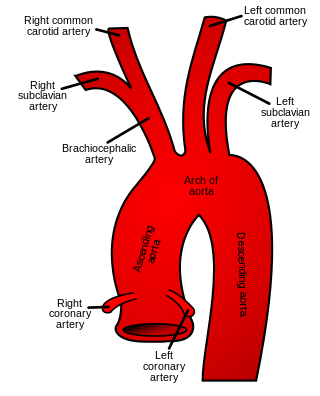Aberrant subclavian artery
| Aberrant subclavian artery | |
|---|---|

Normal anatomical locations of right and left subclavian arteries
|
|
| Classification and external resources | |
| Specialty | Lua error in Module:Wikidata at line 446: attempt to index field 'wikibase' (a nil value). |
| ICD-10 | Q27.8 |
| ICD-9-CM | 747.21 |
| Patient UK | Aberrant subclavian artery |
Aberrant subclavian artery, or aberrant subclavian artery syndrome, is a rare anatomical variant of the origin of the right or left subclavian artery. This abnormality is the most common congenital vascular anomaly of the aortic arch.
Contents
Presentation
The aberrant artery usually arises just distal to the left subclavian artery and crosses in the posterior part of the mediastinum usually behind the oesophagus on its way to the right upper extremity. Such course of this aberrant vessel may cause a vascular ring around the trachea and oesophagus. Dysphagia due to an aberrant right subclavian artery is termed dysphagia lusoria. Palsy of the recurrent laryngeal nerve is termed Ortner's syndrome.
The aberrant right subclavian artery frequently arises from a dilated segment of the proximal descending aorta, the so-called Diverticulum of Kommerell. It is alternatively known as lusorian artery.
Treatment
Surgery is sometimes used to treat the condition.[1]
Images
-
Arteria lusoria Computertomographie.png
Aberrant subclavian artery at axial CT-scan. (1) trachea, (2) esophagus, (3) Aberrant subclavian artery.
-
Dysphagia lusoria.JPG
Aberrant right subclavian artery at angiography.
-
Arteria lusoria Breischluck ap.png
Tape-like impression of the esophagus caused by aberrant subclavian artery. Below (arrows) narrowing of the esophagus by a tumor that is causing the swallowing problems.
-
Arteria lusoria Breischluck.png
Aberrant subclavian artery seen at swallowing study: Impression of the esophagus from behind.
References
- ↑ Lua error in package.lua at line 80: module 'strict' not found.
